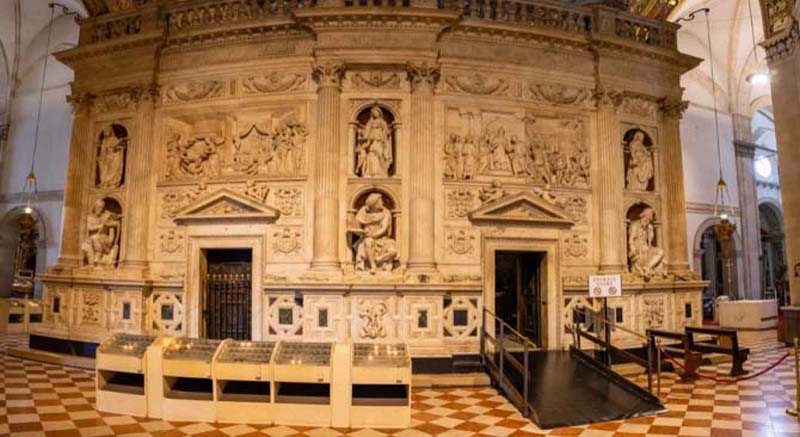Last Updated on November 13, 2025 by Editor
ABOVE: The “Holy House of Mary,” the childhood home of the Virgin, is enclosed in an ornate, Renaissance-era marble monument. The faithful believe it is where the Annunciation took place, setting in motion the birth and life of Jesus. This significant structure is housed in a great Basilica in Loreto, in the Marche region of Italy, a short distance from the Adriatic Sea.
The average American Catholic traveler in Italy is well versed in some of the most highly regarded pilgrimage destinations.
No. 1 would have to be the Vatican as the resting place of St. Peter and the seat of the pope and the Catholic Church. In addition, the dozens of other religious sites in Rome related to our faith make it a smorgasbord of possible holy sites.
Second probably would be Assisi, home of the fabulous Basilica built there to house the mortal remains of the town’s favorite son, St. Francis. He is much admired for his unique example of walking in the footsteps of Jesus through poverty, humility, chastity and devotion. He has become sort of a “super saint” as patron of ecology, a hot button topic in our day.

Recently, the great Basilica of St. Francis has experienced an uptick in visitors as one of our newest saints, Carlo Acutis, the15-year-old first millennial saint, is entombed there. He also strikes a chord with our day as he has been popularly called “the patron saint of the Internet” because of his interest in computers and because he built a website that documented miracles related to the Eucharist.
After these sites, many religious travelers flock to Padova — to the Basilica of St. Anthony, Venice; to the Basilica of St. Mark, Bari; to the Basilica of St. Nicolas or Amalfi; to the Basilica of St. Andrew. The last three of these holy men’s remains were brought to Italy by the Crusaders who, returning home, wanted to be sure that their holy saints would not ever be left in the hands of their adversaries — the Muslims.
Another important relic brought back to Italy at this time is the “Holy House of Mary,” the childhood home of the Virgin. The faithful believe it is where the Annunciation took place, setting in motion the birth and life of Jesus. This significant structure is housed in a great Basilica in Loreto, in the Marche region of Italy, a short distance from the Adriatic Sea. Most American travelers are unfamiliar with the impressive site.
In Israel, in the town of Nazareth, there is the Basilica of the Annunciation. It is built over a grotto, the site where Mary was visited by the Archangel Gabriel and gave her Fiat — her consent to conceive, bear a son and name him Jesus (Luke 1:26-38).
The Basilica of the Annunciation is the largest church in the Middle East. The actual church is modern, consecrated in 1969. However, the site has a long history. Archaeologists have determined there are the ruins of four other churches beneath and around the grotto. This is where the Holy House of Mary had its origins.
Legends say that angels miraculously transported the house over the sea to Loreto in 1294. In the early 1900s, however, a priest and papal archivist was studying Vatican documents when he discovered a ledger detailing items that were brought out of the Holy Land during the Crusades. He read that a Byzantine Greek merchant, with the surname Angelos, financed the expedition and paid the crusaders to move the house to Italy as part a wedding dowry for his daughter, who was to marry Philip of Taranto in 1294. His name would have been Angeli in Latin and Italian, which means “Angels.” This, they say, is the origin of the tradition of the “angels” carrying the House to Italy.
The House of Mary consists of three walls of stacked stones. Scientists have verified their probable origins through chemical analysis. Studies have shown that the stones making up the walls were not cut according to local Italian methods. Furthermore, there are the graffiti on the Loreto walls that are like those found in early Judeo-Christian churches in Palestine before the 5th century. There is a marking on one of the Loreto walls that is identical to one in the Nazareth grotto.
The Holy House is enclosed in an ornate, Renaissance-era marble monument within the basilica, which was built starting in 1468, and is 305 feet long and 200 feet wide. Its belltower is 248 feet high. Around the house is a tall marble screen designed by Bramante with sculptural work by Andrea Sansovino and Raffaello da Montelupo and his pupils. The four sides depict the Annunciation, the Nativity of Jesus, the Arrival of the Santa Casa at Loreto and the Nativity of the Virgin.
Within the little house a niche contains a 33-inch image of the Virgin and Child, adorned with jewels, above the altar. The statue replaces an original one destroyed after a fire in Santa Casa in 1921. Miracles have been attributed to the sacred image.
So, if you plan to visit religious sites in Italy, consider a tip to the lesser-known eastern coast of the country. Among the rolling hills overlooking the Adriatic Sea, you will not be disappointed to visit Loreto.
Sources: www.ncregister.com; www.santuarioloreto.va; https://en.wikipedia.org
